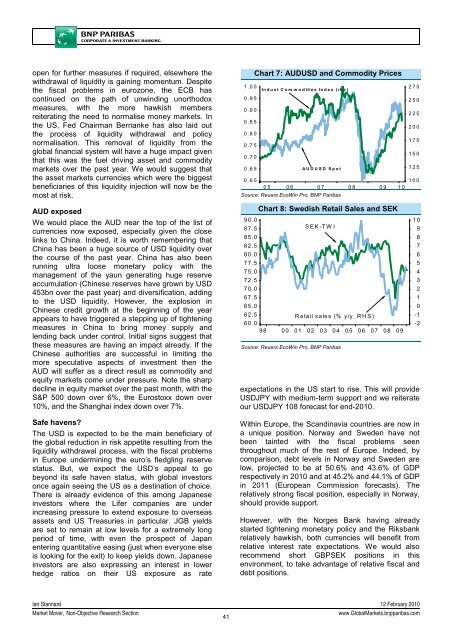Market Mover - BNP PARIBAS - Investment Services India
Market Mover - BNP PARIBAS - Investment Services India
Market Mover - BNP PARIBAS - Investment Services India
Create successful ePaper yourself
Turn your PDF publications into a flip-book with our unique Google optimized e-Paper software.
open for further measures if required, elsewhere the<br />
withdrawal of liquidity is gaining momentum. Despite<br />
the fiscal problems in eurozone, the ECB has<br />
continued on the path of unwinding unorthodox<br />
measures, with the more hawkish members<br />
reiterating the need to normalise money markets. In<br />
the US, Fed Chairman Bernanke has also laid out<br />
the process of liquidity withdrawal and policy<br />
normalisation. This removal of liquidity from the<br />
global financial system will have a huge impact given<br />
that this was the fuel driving asset and commodity<br />
markets over the past year. We would suggest that<br />
the asset markets currencies which were the biggest<br />
beneficiaries of this liquidity injection will now be the<br />
most at risk.<br />
Chart 7: AUDUSD and Commodity Prices<br />
1.00 Indust Commodities Index (rhs)<br />
0.95<br />
0.90<br />
0.85<br />
0.80<br />
0.75<br />
0.70<br />
0.65<br />
AUDUSD Spot<br />
0.60<br />
05 06 07 08 09 10<br />
Source: Reuers EcoWin Pro, <strong>BNP</strong> Paribas<br />
275<br />
250<br />
225<br />
200<br />
175<br />
150<br />
125<br />
100<br />
AUD exposed<br />
We would place the AUD near the top of the list of<br />
currencies now exposed, especially given the close<br />
links to China. Indeed, it is worth remembering that<br />
China has been a huge source of USD liquidity over<br />
the course of the past year. China has also been<br />
running ultra loose monetary policy with the<br />
management of the yaun generating huge reserve<br />
accumulation (Chinese reserves have grown by USD<br />
453bn over the past year) and diversification, adding<br />
to the USD liquidity. However, the explosion in<br />
Chinese credit growth at the beginning of the year<br />
appears to have triggered a stepping up of tightening<br />
measures in China to bring money supply and<br />
lending back under control. Initial signs suggest that<br />
these measures are having an impact already. If the<br />
Chinese authorities are successful in limiting the<br />
more speculative aspects of investment then the<br />
AUD will suffer as a direct result as commodity and<br />
equity markets come under pressure. Note the sharp<br />
decline in equity market over the past month, with the<br />
S&P 500 down over 6%, the Eurostoxx down over<br />
10%, and the Shanghai index down over 7%.<br />
Safe havens?<br />
The USD is expected to be the main beneficiary of<br />
the global reduction in risk appetite resulting from the<br />
liquidity withdrawal process, with the fiscal problems<br />
in Europe undermining the euro’s fledgling reserve<br />
status. But, we expect the USD’s appeal to go<br />
beyond its safe haven status, with global investors<br />
once again seeing the US as a destination of choice.<br />
There is already evidence of this among Japanese<br />
investors where the Lifer companies are under<br />
increasing pressure to extend exposure to overseas<br />
assets and US Treasuries in particular. JGB yields<br />
are set to remain at low levels for a extremely long<br />
period of time, with even the prospect of Japan<br />
entering quantitative easing (just when everyone else<br />
is looking for the exit) to keep yields down. Japanese<br />
investors are also expressing an interest in lower<br />
hedge ratios on their US exposure as rate<br />
Chart 8: Swedish Retail Sales and SEK<br />
90.0<br />
87.5<br />
SEK-TWI<br />
85.0<br />
82.5<br />
80.0<br />
77.5<br />
75.0<br />
72.5<br />
70.0<br />
67.5<br />
65.0<br />
62.5<br />
R etail sales (% y/y, RH S)<br />
60.0<br />
98 00 01 02 03 04 05 06 07 08 09<br />
Source: Reuers EcoWin Pro, <strong>BNP</strong> Paribas<br />
10<br />
9<br />
8<br />
7<br />
6<br />
5<br />
4<br />
3<br />
2<br />
1<br />
0<br />
-1<br />
-2<br />
expectations in the US start to rise. This will provide<br />
USDJPY with medium-term support and we reiterate<br />
our USDJPY 108 forecast for end-2010.<br />
Within Europe, the Scandinavia countries are now in<br />
a unique position. Norway and Sweden have not<br />
been tainted with the fiscal problems seen<br />
throughout much of the rest of Europe. Indeed, by<br />
comparison, debt levels in Norway and Sweden are<br />
low, projected to be at 50.6% and 43.6% of GDP<br />
respectively in 2010 and at 45.2% and 44.1% of GDP<br />
in 2011 (European Commission forecasts). The<br />
relatively strong fiscal position, especially in Norway,<br />
should provide support.<br />
However, with the Norges Bank having already<br />
started tightening monetary policy and the Riksbank<br />
relatively hawkish, both currencies will benefit from<br />
relative interest rate expectations. We would also<br />
recommend short GBPSEK positions in this<br />
environment, to take advantage of relative fiscal and<br />
debt positions.<br />
Ian Stannard 12 February 2010<br />
<strong>Market</strong> <strong>Mover</strong>, Non-Objective Research Section<br />
41<br />
www.Global<strong>Market</strong>s.bnpparibas.com
















